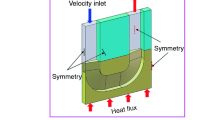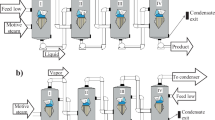Abstract
In case of dropwise evaporation process, the significant reduction of the Leidenfrost effect has been a challenging task for the current generation research due to the counter current characteristics of drag and inertial forces. The alignment of the above stated forces in one direction reduces the Leidenfrost effect significantly as the vapour flow and droplet impingent occur in the same direction. In case of spray cooling from very high initial temperatures, this is achieved by changing the orientation of spray from the downward direction to upward direction. Furthermore, the upward spray is enhanced by altering the thermo physical properties in the favourable direction of heat transfer. In the current work, benzene is added as an additive for attainment of the above stated. The thermal analysis clearly ensures the enhancement in case of benzene added water upward spray, and the achieved average heat flux is 1.78 MW m−2. The discussed value is almost 1.3 times higher than the heat flux obtained in case quenching is conducted by downward spray. The theoretical calculation supports the information discussed above. It indicates that in case of upward spray, the contact area and spreading factor are higher than the down case. After the cooling operations, the utilised coolant analysis indicates that the found to (Fe)Total and TDS levels augment. Therefore, the utilised coolant should be treated to achieve lower TDS level before reutilisation or exposure to the open environment.









Similar content being viewed by others
Abbreviations
- \(A\prime\) :
-
Heat transfer area of the droplet, m2
- \(T_{{\text{f}}}\) :
-
Final temperature of the coolant, °C
- C pl :
-
Specific heat of the coolant in liquid phase, J kg−1 °C−1
- C pv :
-
Specific heat of the coolant in vapour phase, J kg−1 °C−1
- D :
-
Diameter of the droplet, mm
- D f :
-
Final spreading diameter after the droplet spreading, mm
- D max :
-
Maximum spreading diameter after impingement, mm
- \(h\) :
-
Heat transfer coefficient, Wm−2 K−1
- \(h_{{\text{v}}}\) :
-
Latent heat of vaporisation, J kg−1
- k :
-
Thermal conductivity of the coolant, Wm−1 °C−1
- Re:
-
Reynolds number
- St:
-
Stanton number
- T l :
-
Coolant temperature, °C
- T s :
-
Saturation temperature, °C
- T w :
-
Hot plate temperature, °C
- V :
-
Velocity of the droplet during spreading, m s−1
- V 1 :
-
Initial velocity of the droplet, m s−1
- V 2 :
-
Final velocity of the droplet, m s−1
- We:
-
Weber number
- \(m\) :
-
Mass of the droplet, kg
- \(n\) :
-
Number of droplets impinging per second. s−1
- \(q\) :
-
Surface heat flux, MW m−2
- µ :
-
Viscosity of the coolant, Pa s
- θ :
-
Contact angle of the coolant, degree
- ρ :
-
Density of the coolant, kg m−3
- σ :
-
Surface tension of the coolant, mN m−1
- λ :
-
Latent heat of vaporization of coolant, J kg−1
- IF:
-
Inertia force, N
- VF:
-
Viscous force, N
- CF:
-
Capillary force, N
References
Jowkar S, Morad MR. Rebounding suppression of droplet impact on hot surfaces: effect of surface temperature and concaveness. Soft Matter. 2019;15:1017–26.
Hashmi A, Xu Y, Coder B, Osborne PA, Spafford J, Michael GE, et al. Leidenfrost levitation: beyond droplets. Sci Rep. 2012;2:797.
Graeber G, Regulagadda K, Hodel P, Küttel C, Landolf D, Schutzius TM, et al. Leidenfrost droplet trampolining. Nat Commun. 2021;12:1727.
Leidenfrost JG. On the fixation of water in diverse fire. Int J Heat Mass Transf. 1966;9:1153–66.
Bernardin JD, Mudawar I. The Leidenfrost point: experimental study and assessment of existing models. J Heat Transf. 1999;121:894–903.
Kim SH, Jiang Y, Kim H. Droplet impact and LFP on wettability and nanostructured surface. Exp Therm Fluid Sci. 2018;99:85–93. https://doi.org/10.1016/j.expthermflusci.2018.07.029.
Park J, Kim DE. Dynamics of liquid drops levitating on superheated surfaces. Int J Therm Sci. 2020;152:106321. https://doi.org/10.1016/j.ijthermalsci.2020.106321.
Chatzikyriakou D, Walker SP, Hewitt GF, Narayanan C, Lakehal D. Comparison of measured and modelled droplet-hot wall interactions. Appl Therm Eng. 2009;29:1398–405.
Wildeman S, Visser CW, Sun C, Lohse D. On the spreading of impacting drops. J Fluid Mech. 2016;805:636–55.
Liang G, Mudawar I. Review of spray cooling–Part 2: high temperature boiling regimes and quenching applications. Int J Heat Mass Transf. 2017;115:1206–22. https://doi.org/10.1016/j.ijheatmasstransfer.2017.06.022.
Chandra S, Avedisian CT. On the collision of a droplet with a solid surface. Proc R Soc A Math Phys Eng Sci. 1991;432:13–41.
Kim SH, Lee G, Kim HM, Kim MH. Leidenfrost point and droplet dynamics on heated micropillar array surface. Int J Heat Mass Transf. 2019;139:1–9. https://doi.org/10.1016/j.ijheatmasstransfer.2019.04.093.
Makino K, Michiyoshi I. Discussions of transient heat transfer to a water droplet on heated surfaces under atmospheric pressure. Int J Heat Mass Transf. 1987;30:1895–905.
Crafton EF, Black WZ. Heat transfer and evaporation rates of small liquid droplets on heated horizontal surfaces. Int J Heat Mass Transf. 2004;47:1187–200.
Bernardin JD, Mudawar I, Walsh CB, Franses EI. Contact angle temperature dependence for water droplets on practical aluminum surfaces. Int J Heat Mass Transf. 1997;40:1017–33.
Park JK, Ryu J, Koo BC, Lee S, Kang KH. How the change of contact angle occurs for an evaporating droplet: Effect of impurity and attached water films. Soft Matter. 2012;8:11889–96.
Liu L, Zhang Y, Cai G, Tsai PA. High-speed dynamics and temperature variation during drop impact on a heated surface. Int J Heat Mass Transf. 2022;189:122710.
Ravikumar SV, Jha JM, Sarkar I, Pal SK, Chakraborty S. Mixed-surfactant additives for enhancement of air-atomized spray cooling of a hot steel plate. Exp Therm Fluid Sci. 2014;55:210–20.
Mohapatra SS, Ravikumar SV, Andhare S, Chakraborty S, Pal SK. Experimental study and optimization of air atomized spray with surfactant added water to produce high cooling rate. J Enhanc Heat Transf. 2012;19:397–408.
Pati AR, Behera AP, Munshi B, Mohapatra SS. Enhancement of heat removal rate of high mass flux spray cooling by sea water. Exp Therm Fluid Sci. 2017;89:19–40.
Bhatt NH, Pati AR, Kumar A, Behera A, Munshi B, Mohapatra SS. High mass flux spray cooling with additives of low specific heat and surface tension: a novel process to enhance the heat removal rate. Appl Therm Eng. 2017;120:537–48.
Biswal NR, Rangera N, Singh JK. Effect of different surfactants on the interfacial behavior of the n-hexane–water system in the presence of silica nanoparticles. J Phys Chem B. 2016;120:7265–74. https://doi.org/10.1021/acs.jpcb.6b03763.
Ahsani Arani Y, Noormohammadi Z, Rasekh B, Yazdian F, Kazemi H. Evaluation of SDS-coated iron nanostructure on the gene expression of bio surfactant-producing genes by Pseudomonas aeruginosa. Eng Life Sci. 2022;22:584–93.
Yang S, Hou Y, Zhou D, Zhong X. Non-monotonic effect of ethanol concentration on the spreading of an ethanol-water binary droplet impact on a supercooled surface. Int J Therm Sci. 2023;183:107828.
Biswal NR, Singh JK. Interfacial behavior of nonionic Tween 20 surfactant at oil-water interfaces in the presence of different types of nanoparticles. RSC Adv. 2016;6:113307–14.
Kwaśniewska D, Kiewlicz J. Study of interaction between cationic surfactant (CTAB) and ascorbic acid/ascorbic acids derivatives by tensiometric and spectroscopic methods. J Mol Liq. 2022;354:118917.
He S, Ni Y, Lu L, Chai Q, Liu H, Yang C. Enhanced biodegradation of n-hexane by Pseudomonas sp. strain NEE2. Sci Rep. 2019;9:16615.
Mahapatra AS, Kar SP, Swain A. Experimental analysis of saturated pool boiling of acetone and isopropanol with added surfactant sodium lauryl sulfate over aluminum surface. Heat Transf. 2022;51:3853–68. https://doi.org/10.1002/htj.22480.
Kerscher M, Fröba AP, Koller TM. Viscosity and surface tension of benzene at saturation conditions from surface light scattering. Int J Thermophys. 2021;42:1–5.
Pati AR, Kumar A, Mohapatra SS. Upward and downward facing high mass flux spray cooling with additives: a novel technique to enhance the heat removal rate at high initial surface temperature. Heat Mass Transf. 2018;54:1669–80.
Lohtander T, Herrala R, Laaksonen P, Franssila S, Österberg M. Lightweight lignocellulosic foams for thermal insulation. Cellulose. 2022;29:1855–71. https://doi.org/10.1007/s10570-021-04385-6.
Baek S, Yong K. Impact dynamics on SLIPS: effects of liquid droplet’s surface tension and viscosity. Appl Surf Sci. 2020;506:144689.
Pati AR, Panda A, Munshi B, Kumar A, Sahoo A, Ghosh S, Mohapatra SS. Dropwise evaporative cooling of hot water: a novel methodology to enhance heat transfer rate at very high surface temperatures. Int J Therm Sci. 2018;1(127):335–50. https://doi.org/10.1016/j.ijthermalsci.2018.01.028.
Kim HY, Chun JH. The recoiling of liquid droplets upon collision with solid surfaces. Phys Fluids. 2001;13:643–59.
Trujillo DM, Busby HR. INTEMP—Inverse heat transfer analysis-user’s manual [Internet]. Trucomp Co., Fountain Val. Canada. Fountain Valley, CA; 2003. p. 1–47. Available from: https://sites.google.com/site/trucompp/intemp
Pati AR, Bhatt NH, Das L, Teja S, Nayak S, Kumar A, et al. The discrepancy in the prediction of surface temperatures by inverse heat conduction models for different quenching processes from very high initial surface temperature. Inverse Probl Sci Eng. 2019;27:808–35.
Pati AR, Swain B, Mohapatra SS. The boiling phenomena and their proper identification and discrimination methodology. Sci Rep. 2020;10(1):8381. https://doi.org/10.1038/s41598-020-65342-0.
Bhatt NH, Raj R, Varshney P, Pati AR, Chouhan D, Kumar A, Munshi B, Mohapatra SS. Enhancement of heat transfer rate of high mass flux spray cooling by ethanol-water and ethanol-tween20-water solution at very high initial surface temperature. Int J Heat Mass Transf. 2017;1(110):330–47. https://doi.org/10.1016/j.ijheatmasstransfer.2017.02.094.
Author information
Authors and Affiliations
Corresponding author
Additional information
Publisher's Note
Springer Nature remains neutral with regard to jurisdictional claims in published maps and institutional affiliations.
Rights and permissions
Springer Nature or its licensor (e.g. a society or other partner) holds exclusive rights to this article under a publishing agreement with the author(s) or other rightsholder(s); author self-archiving of the accepted manuscript version of this article is solely governed by the terms of such publishing agreement and applicable law.
About this article
Cite this article
Ravikumar, K.P., Sahoo, A. & Mohapatra, S.S. Enhancement of upward facing spray cooling by benzene added water. J Therm Anal Calorim 148, 4541–4551 (2023). https://doi.org/10.1007/s10973-023-12035-1
Received:
Accepted:
Published:
Issue Date:
DOI: https://doi.org/10.1007/s10973-023-12035-1




